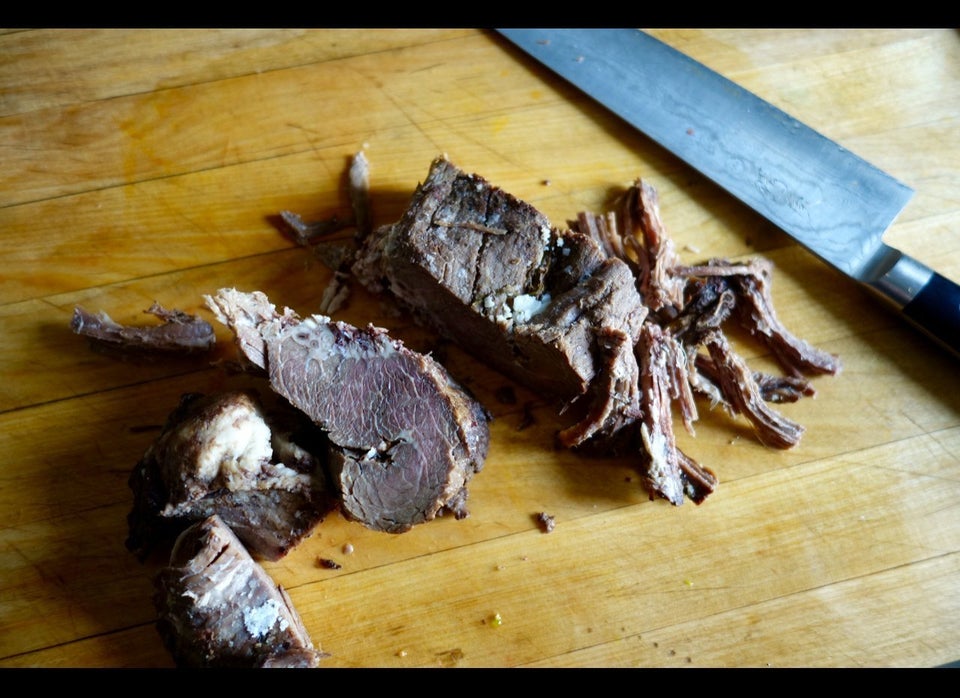During the New York part of my university "studies," I had the best after-school job in the world: ushering at the Metropolitan Opera House. Between cutting classes all day and working, most nights, from 7 to 11 p.m. or later, this made for a long slog. A cheap and delicious dinner was important, and happily there were lots of options on the Upper West Side - or elsewhere, depending on how much time I had on my hands.
A favorite restaurant genre was the Cuban-Chinese diner/café, with counter seating plus booths and tables; not so many of these places remain, and there is no up-side to that. There were lots in the 1960s and '70s, however, and I ate in them pretty often. In most Cuban-Chinese diners, the Asian side of the menu was of little interest to someone whose regular itinerary included Chinatown (apart from restorative Sopa China: chicken broth with shredded meat and won tons, with a raw egg yolk slipped into it). The interest lay among the home-style Cuban dishes bolstered with fried plantains and rice and beans. My two standbys were picadillo (made of chopped meat) and ropa vieja (using shredded meat - and meaning "old clothes"). It would take a coin-toss for Jackie or me to declare a preference; they're both comforting and delicious and the kind of thing it's almost impossible to get tired of.
My take on ropa vieja is what I made one recent evening; served with rice, the batch fed five people. The principle of this version is that you simmer beef with long muscle fibers (to put it in different terms, stringy beef), then, when it is tender, pull it apart into shreds and use the broth in which you simmered it as the liquid for the rest of the process. Invariable flavors are onions, garlic, peppers, tomato and vinegar; nearly invariable is the inclusion of olives and, sometimes, capers. But proportions and shopping list vary from household to household - there's lots of scope for tailoring the recipe to your needs.
I used pre-existing meat and broth: In the freezer was a well-preserved 12-ounce (340-gram) piece of cooked beef brisket and an unrelated quart (liter) of lightly-flavored veal stock. If you're starting from scratch, simmer the beef - the most common cut is flank steak, but I use short rib or brisket with excellent outcomes - with leek or onion, carrot and parsley, plus a few peppercorns, a clove and some salt. When it is tender and the water has become a broth (it needn't be a rich one), let the meat cool in the liquid, then proceed either immediately or within a few days.
Shred the meat with your fingers, pulling bundles of fibers off each piece; for ease of eating, aim for shreds between 1-1/2 and 2 inches (4 to 7 cm) long, if necessary cutting the meat across the grain to achieve this. Set the meat aside and assemble a good-size onion, a couple of peppers (thin-fleshed "frying peppers" are best, and you can mix green and red) and, if you like, a not-too-hot chili like a poblano; cut them all into eighth-inch (generous 3-mm) strips. It wouldn't be wrong-headed to include half a stalk of celery or a little carrot, julienned, but there's no need for either. Slice or mince a big clove of garlic or two small ones. In olive oil over medium-low heat, sweat the onion and garlic with salt and pepper; add half a teaspoon each of ground cumin and ground coriander seed (inauthentic but delicious). When the onion is getting soft, add the peppers and ask yourself whether the pan needs more olive oil. You can raise the heat to medium, and when the peppers too have begun to soften add, say, a cup and a half (350 ml) of broth and a tomato element. This can be a squirt of tomato paste or half a cup of plain tomato sauce or a smallish fresh tomato chopped fine. Taste for salt and stir in the shredded beef. It should be pretty well bathed in broth and vegetables; add more broth if necessary, and if you have no more add water. Now is a good time to add vinegar. I use a particularly good cider vinegar for this dish, but nice wine vinegar or sherry vinegar works very well. Start with a tablespoonful; its bright acidity should be discernable but not startling, and you can (and probably will) add more later.
Bring to the simmer and cook gently for 20 minutes with the pan lid ajar. Now add a big handful of sliced pitted olives; green Spanish varieties are ideal. Taste for vinegar and seasoning in general. (Many cooks add capers too. I don't: to my mind they shift the dish from the Caribbean to the Mediterranean.) Simmer for another 10 minutes.
It is not uncommon for this dish to be cooked for a long time; my preference is to keep the color bright and let the peppers retain some texture, though certainly no crunch. And the meat has already been cooked, so your job now is to let it soak up the sauce (I don't think it actually does absorb liquid, but the loose bunches of fibers make it appear so).
Ropa vieja can be made a couple of hours or a few days in advance. It reheats well, so make more than the amount I've described: if you do, don't simply multiply the quantities, but use your judgment about the proper balance. As long as the seasoning is right and there are plenty of onions and peppers, you can't go far wrong.
Eat ropa vieja with plain white rice for sure; if you feel like making rice and beans, no one will complain. I never did at the Jardín de China.
